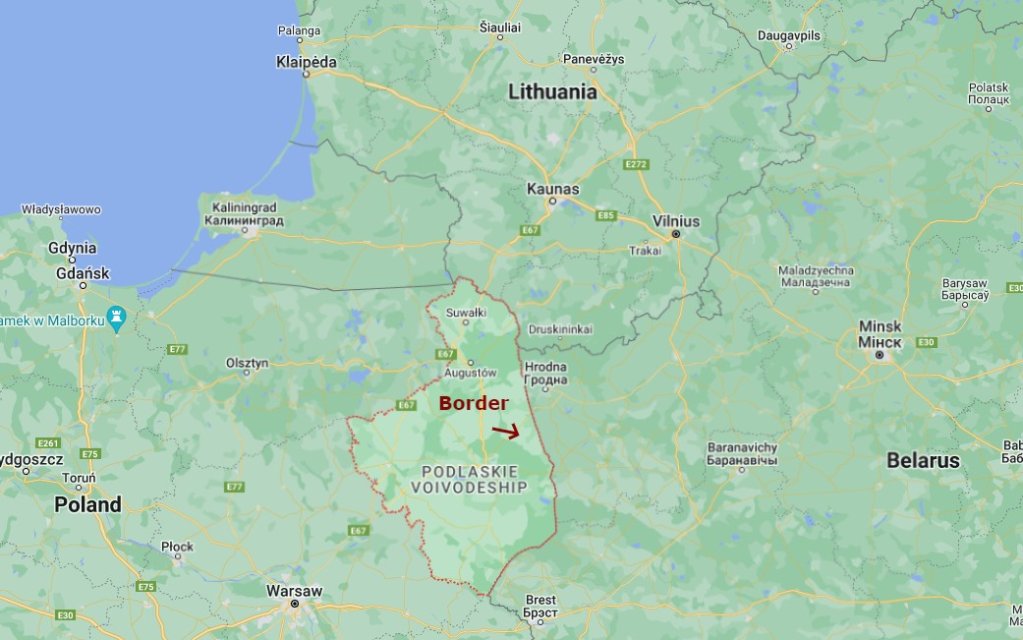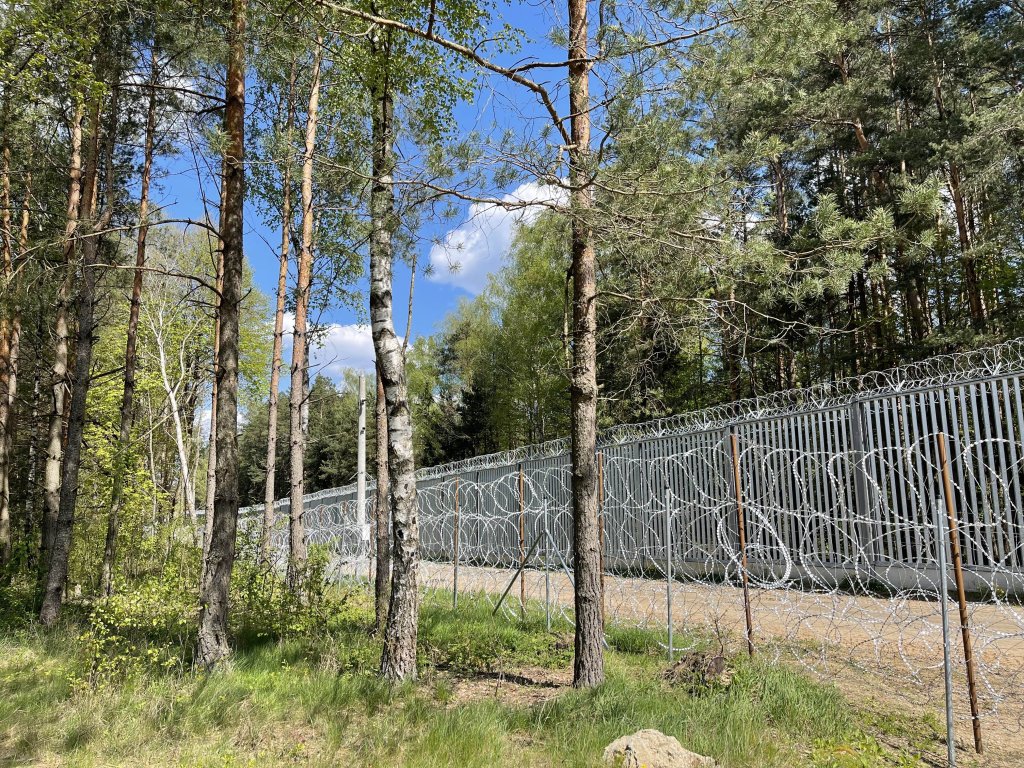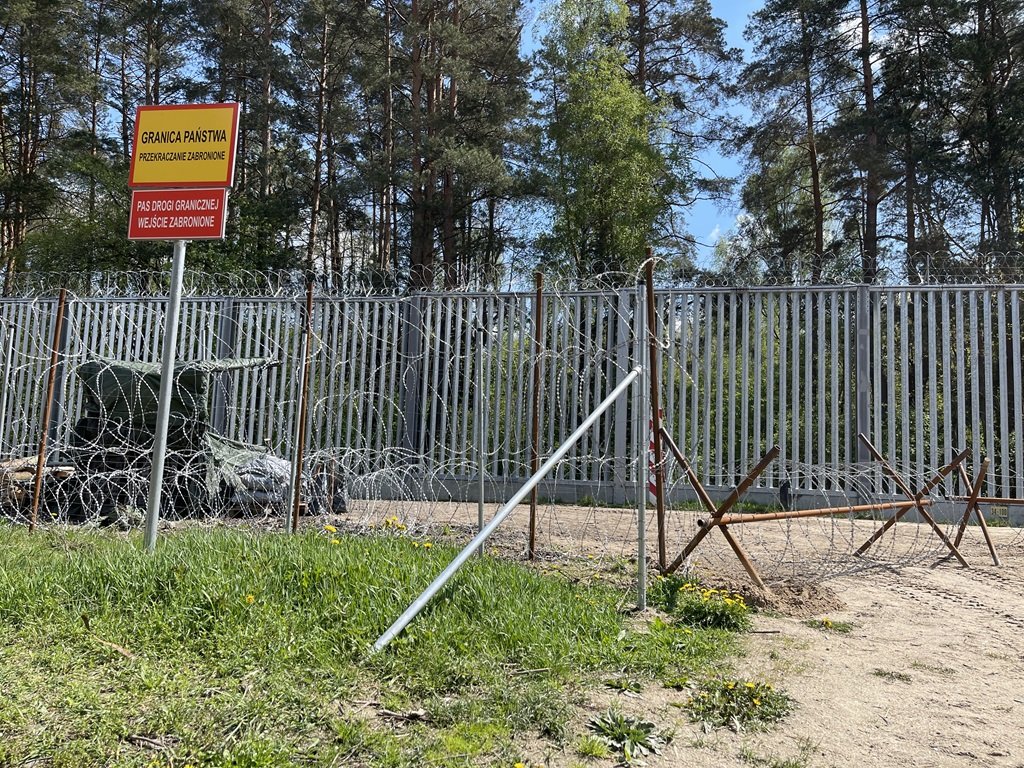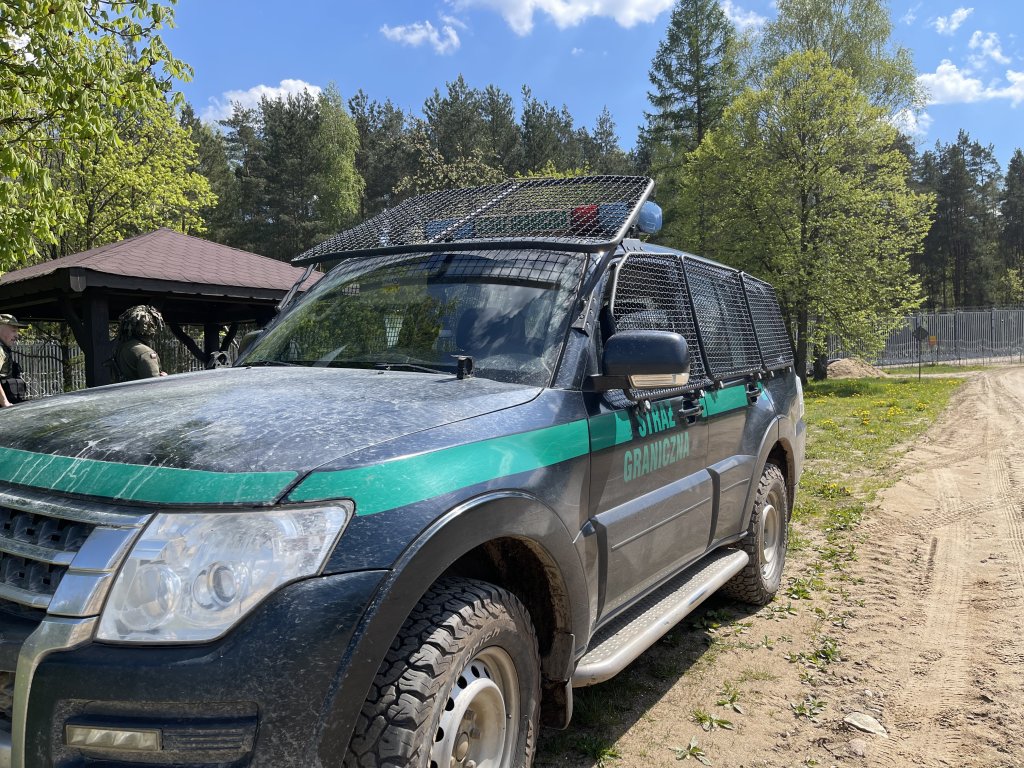The border between Poland and Belarus is an extremely dangerous and inhospitable zone for migrants. Like Ali, Abdou and Solomon, tens of thousands of people risk their lives every year by attempting to enter the European Union via this route.
Sunday is a typically peaceful day in Czerlonka, a small village which is home to 120 inhabitants in eastern Poland. Under the bright April sunshine, a teenager wearing pink headphones is in motion on a swing, while a couple in sportswear cycle along the main dirt path which leads into the thick forest.
Along the same trail, only several hundred meters away, a group of eight Ethiopian migrants try to regain their strength. Despite the warm weather, they are wearing coats and thick hoodies. One of them has just drank nearly an entire bottle of water brought by members of the Podlaskie Voluntary Humanitarian Emergency Service, POPH, a local NGO.
After 45 days in the Belarusian forest, and four without food, they are finally in the European Union (EU). "We are exhausted, but we have finally arrived. That is what counts the most," says Solomon with a sigh. A few smiles appear on the migrants' faces; their features gaunt after the long journey.

Crossing into Poland
The migrants have arrived in Poland after crossing the Belarusian border, just like thousands of other migrants have been doing since 2021.
Back then, the EU accused the Belarusian President Alexander Lukashenko and close ally of Russian President Vladimir Putin of a "hybrid attack," after some 10,000 migrants, who had arrived in Minsk with visas, were forced across the border into Poland by Belarusian security guards.
The migrants were intercepted by Polish border guards near the village of Usnarz Gorny. The images of the migrants, along with hundreds of children trapped behind barbed wire, were plastered across media channels.
Also read: Poland: New government, new year, but is there a new migration policy?
The forest appears to have regained its calm since then. Yet while the kinds of numbers that arrived in 2021 has dwindled, small groups of migrants are still passing through the region on a regular basis.
They are simply less visible, since their route now spans the entire Podlaski region, which covers three-quarters of the 186-kilometer border that Poland shares with Belarus. According to Katarzyna Zdanowicz, a spokesperson for the Polish Border Patrol, 26,000 attempted crossings were detected in 2023, compared to 15,700 in 2022, and 35,000 in 2021.
Since January 1, 2024, 8,200 attempts to cross the border have been recorded --the same person might make several attempts before finally succeeding in crossing the border, which may boost the figure.
Fractures, injuries, and paralysis
While Polish authorities allowed some two million Ukrainians fleeing the Russian invasion to cross the country's southern border, the Podlaski border region remains totally closed to Syrian, Iraqi, Afghan, Somali, Ethiopian, or Sudanese nationals fleeing war or disastrous economic circumstances.
Also read: 'If no one wants me, then I want myself' Hila's tale
Poland further reinforced its hardline stance in July 2022, when it completed the construction of a fence. The barrier is 186-kilometers long and five-meters high, topped with barbed wire, and spans the entire border with Belarus. The fence’s height recently doubled when more barbed wire was added. The surrounding area is filmed 24-hours a day by thermal imaging cameras, and monitored by drones, police, and military patrols.

These measures "limit the number of people passing through and allow us to see how people arrive in Poland", said Zdanowicz. Yet "it doesn't stop them completely." Above all, the wall makes crossing the border much more dangerous for migrants.
Médecins Sans Frontières (MSF), present in the area since November 2022, has noted "an increase in fractures among the people it assists." Once they reach the top of the fence with a ladder, the migrants jump to the other side. "They break their ankles, legs and arms," said Joanna Ladomirska, a medical coordinator for the NGO.
"A few months ago, someone was paralyzed after falling on his back," said Faustyn, from the Grupa Granica collective. Many are also injured by the razor-sharp barbed wire. "Some of the people we help have the skin ripped off of their hands," he said.
Read more: Europe finds appeal in border fences once again
Ali*, a 25-year-old Syrian migrant, climbed the fence using a ladder along with four other Syrians. “When they jumped to the other side, one of them broke his leg," said Ali. Yet they had to keep going. They would walk a few minutes, then take a break. Then they would start again, only to stop again. "He was in a really bad state," said Ali about his companion.
In another case in October 2023, a man died after falling from the fence. He was part of a small group that had climbed the fence, according to Grupa Granica. They were chased by border guards on the Polish side, and the migrant was arrested while trying to cross a swamp. He died before the ambulance arrived. "We later learned he had broken a rib when he fell from the fence, and this affected his vital organs," said Faustyn.
Legal pushbacks
Another sign of the Polish government's tougher stance is the increase in the number of law enforcement officers in the area around the village of Bialowieza, the epicenter of the crossings. A total of 2,000 border guards patrol the forest roads of Podlaski every day, supported by several hundred soldiers. This makes it virtually impossible for migrants not to be arrested once they have crossed the fence.
Also read: From amputated digits to death, the effects of cold at Europe's borders
As part of the procedure, each migrant intercepted must answer two questions asked by an officer: "Are you in good health?" and "Do you want to apply for asylum?"
"Most migrants are in good health and don't want protection,” said Zdanowicz. "In this case, we send them back to the Belarusian side, by opening a door in the fence." This constitutes a form of pushback legalized by Warsaw in October 2021, a measure which runs contrary to the Geneva Convention that Poland signed in 1991. Between July 1, 2023, and January 16, 2024, 6,070 pushbacks were carried out by Polish border guards, according to Zdanowicz.
If a migrant says that he or she wishes to seek protection, they are then transferred to "an open detention center [where it is possible to leave during the day, editor’s note] or a closed one, depending on whether or not they have identity papers," added the spokeswoman.

This is the procedure in theory but in practice, the arrests taking place in the forest out of the public's sight are sometimes far more brutal say activists. "It all depends on which guard the migrants come across," said Faustyn. "Some do their job, while others abuse their authority. Migrants often tell us about being sprayed with tear gas immediately after being arrested, for no reason at all."
A migrant named Ahmed reported the following to Grupa Granica last October: "The [Polish] soldiers grab you, scream, slap you, hit you on the ground, tie your hands behind your back, crush your face to the ground with their shoes. Then they throw you over the fence."
Also read: On the fringes of the EU, an embattled civil society persists in helping refugees
It is also hard to know whether the rights of would-be asylum seekers are being respected in these conditions. "Sometimes the guards make them sign a paper in Polish, which they don't understand, with the sentence, 'I don't want to apply for asylum,' and then they are turned back to Belarus," said Kaja from POPH.
A volunteer tried to inform a group of Ethiopian migrants about this practice, who were later found by two teams of border guards on April 28, telling them, "Don't sign anything that isn't in Amharic. Do you understand? It's very important. Don't sign anything."

The border guards sometimes bring in interpreters to help arrested migrants, said Zdanowicz. "Yet there are so many nationalities. On the spot, you can guess without speaking the same language whether a person is in good health or not. We understand each other. If it's too complicated, we use a translator over the phone."
'Impossible to stop vomiting'
These obstacles to gaining asylum --including pushbacks and various forms of violence-- take place in a natural environment which is already very hostile. Full of swamps, the Bialowieza Forest covers a total area of 141,885 hectares. Migrants often wander for weeks or even months at a time. As a result of prolonged exposure to damp, unsanitary conditions and the cold, many suffer from "trench foot", a form of injury that was widespread during the First World War. If the foot is not rapidly treated, gangrene sets in, and the foot may need to be amputated.
Like Ali, many people find themselves drinking water from rivers and swamps to survive. When he was arrested, it was "impossible" for the young man to "stop vomiting". His condition required an emergency transfer to the hospital. "Between the beatings in Belarus, the fence, and this forest, frankly, you shouldn’t be too attached to life to come here. This border is a nightmare," he said. Since the end of 2021, 55 people have died in the area, say NGOs.

For Abdou*, who now lives in Warsaw, talking about his time in the forest is still painful. In May 2023, after several failed attempts, the Senegalese man and his wife, who was several weeks pregnant, finally entered Poland. "She had already been losing blood for several hours. We asked someone who was chopping wood for help. But she called the police."
When the police arrived, Abdou "begged" them to take his wife to hospital, whose stomach pains were preventing her from walking. Instead of an ambulance, all she received were sanitary towels. The couple was then taken back to the border with Belarus. Once in Belarus, they were taken to Lithuania, north of Poland. They walked for four hours and finally crossed the border back into Poland. Abdou immediately called an NGO. "Her pants were soaked in blood. It was then that we understood that we wouldn't be parents."
*All first names have been changed to protect their identities
Marlène Panara traveled recently to the Polish-Belarusian border
